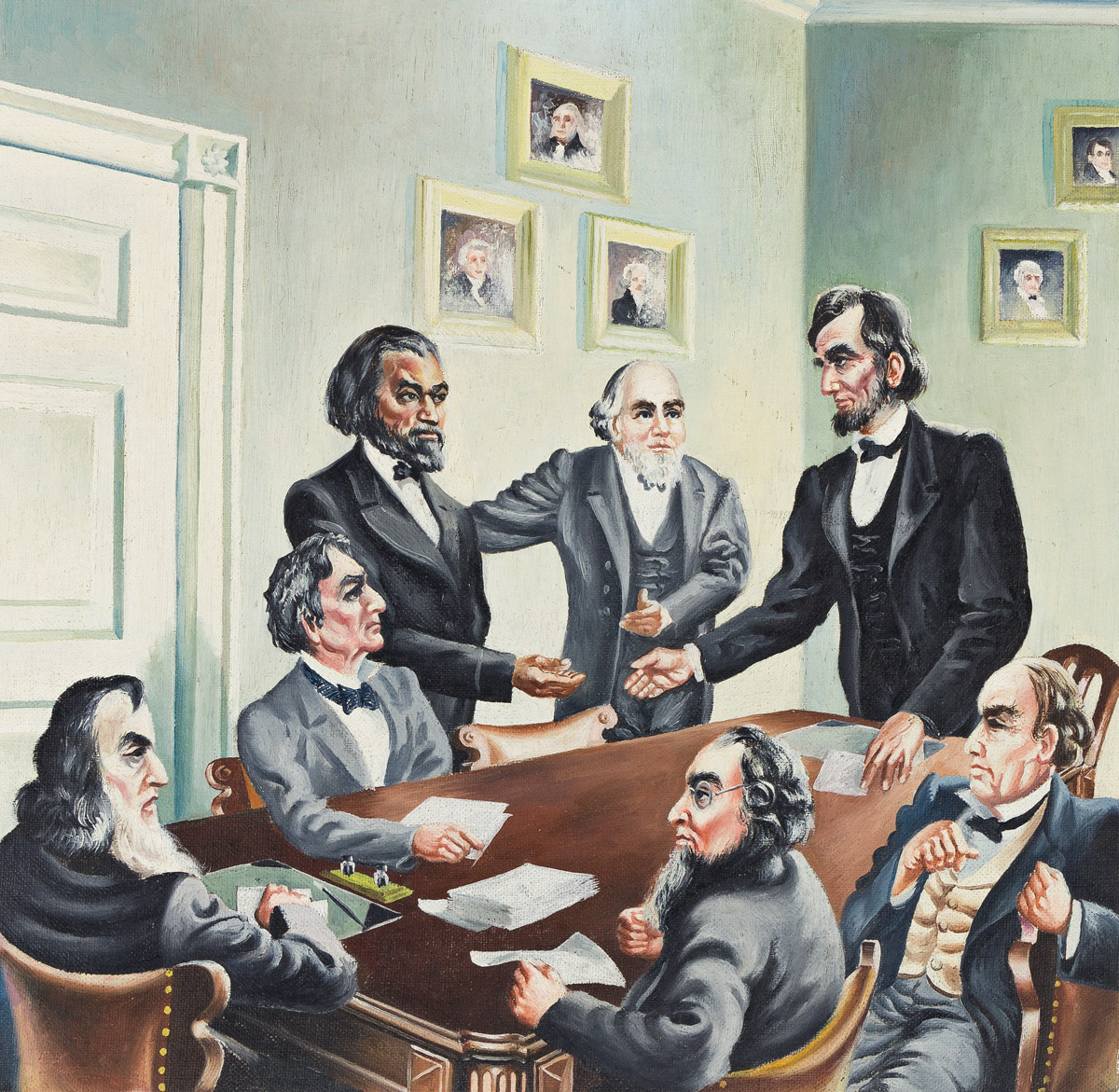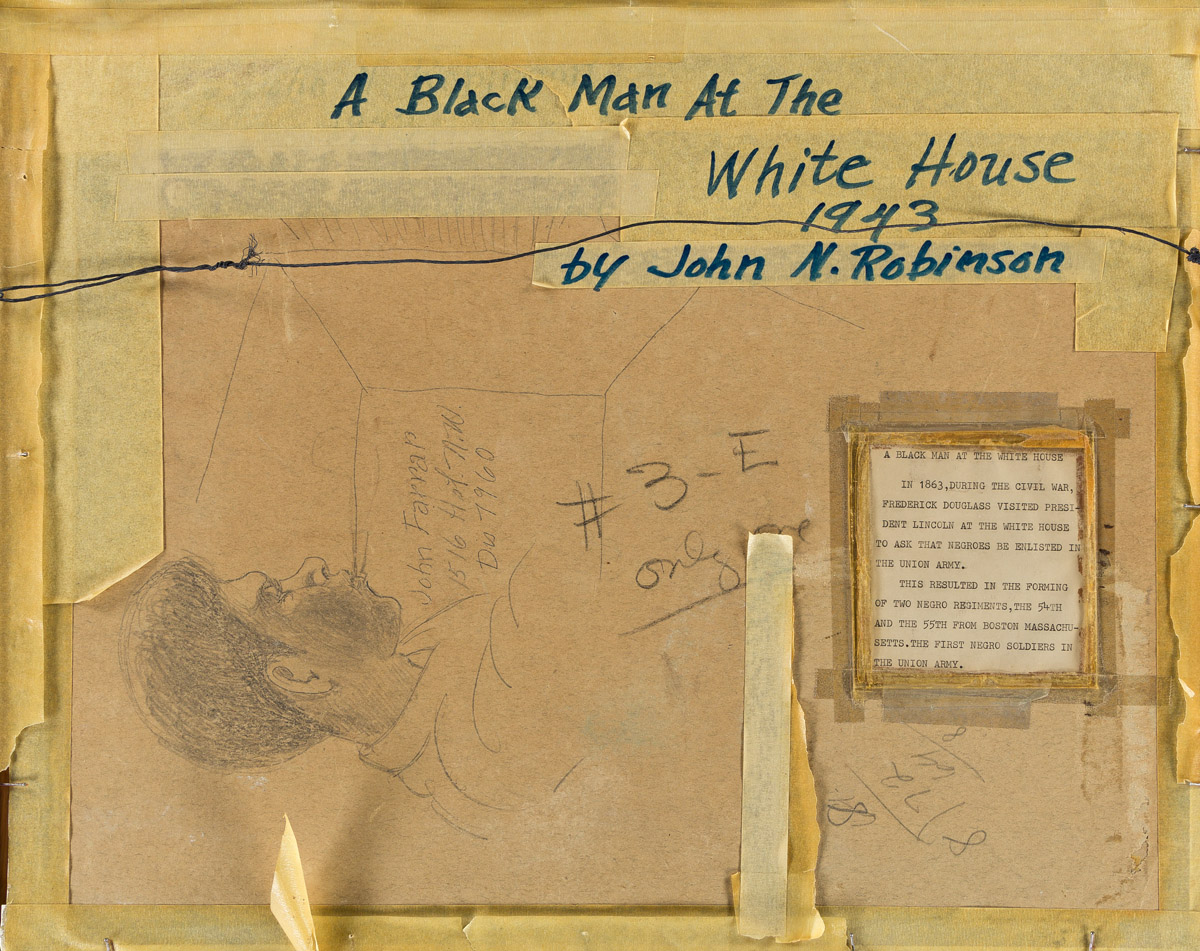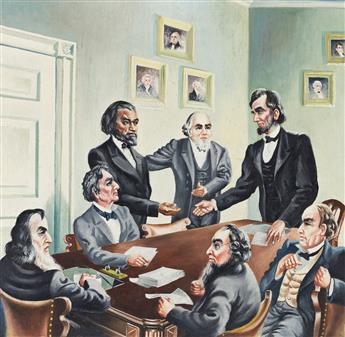Sale 2581 - Lot 20
Unsold
Estimate: $ 12,000 - $ 18,000
JOHN N. ROBINSON (1912 - 1994)
A Black Man at the White House.
Oil on canvas board, 1943. 292x292 mm; 11 1/2x11 1/2 inches (image); 406x508 mm; 16x20 inches (board). Signed, titled and dated in felt tip marker and blue ink, verso. With a pencil sketch of the artist John Farrar, and inscribed with Farrar's Washington, DC address on the verso.
Provenance: collection of the artist, with the artist's typed label on the verso; private collection, Washington, DC. (circa 1979-80), acquired from Aldous Ealey and the Barnett-Aden Gallery, Washington, DC.
Exhibited: John Robinson: A Retrospective, Corcoran Gallery of Art, Washington, DC, June 18 - July 30, 1976.
Illustrated: Adolphus Ealey, John R. Kinard and Roy Slade, John Robinson: A Retrospective, the Anacostia Neighborhood Museum, Smithsonian Institution, in cooperation with the Corcoran Gallery of Art, Washington, DC, p. 31. The catalogue notes quote Robinson: "this (painting) was done for a mural competition at the Recorder of Deeds Office; it depicts Senator Pomeroy introducing Frederick Douglass to President Lincoln".
Frederick Douglass famously visited President Abraham Lincoln in August of 1863, without an appointment. On the way to the White House, Douglass met Samuel C. Pomeroy, a senator from Kansas, who introduced him to the President. The artist's typed description reads; "A Black Man at the White House. In 1863, during the Civil War, Frederick Douglass visited President Lincoln at the White House to ask that Negores be enlisted in the Union Army. This resulted in the forming of the two Negro regiments, the 54th and the 55th from Boston, Massachusetts. The First Negro Soliders in the Union Army."
This historical scene is an early, significant painting by John N. Robinson, a great artist whose work rarely comes to auction. This native Washington, DC painter should be considered a significant modern portrait artist alongside Archibald M. Motley. Robinson excelled at warm depictions of African American friends and family, in addition a series of striking self-portraits. Despite a long career and museum exhibitions, Robinson's work went largely unheralded outside of Washington, DC during his lifetime. Robinson received recognition for his painting late in his career with a solo exhibition at the Corcoran Gallery of Art in 1976, and a retrospective at the Anacostia Museum and Center for African American History and Culture in 1983. His paintings are found today in the permanent collections of the National Portrait Gallery, the Birmingham Museum of Art, the Anacostia Community Museum, the Smithsonian American Art Museum and the Howard University Gallery of Art.
A Black Man at the White House.
Oil on canvas board, 1943. 292x292 mm; 11 1/2x11 1/2 inches (image); 406x508 mm; 16x20 inches (board). Signed, titled and dated in felt tip marker and blue ink, verso. With a pencil sketch of the artist John Farrar, and inscribed with Farrar's Washington, DC address on the verso.
Provenance: collection of the artist, with the artist's typed label on the verso; private collection, Washington, DC. (circa 1979-80), acquired from Aldous Ealey and the Barnett-Aden Gallery, Washington, DC.
Exhibited: John Robinson: A Retrospective, Corcoran Gallery of Art, Washington, DC, June 18 - July 30, 1976.
Illustrated: Adolphus Ealey, John R. Kinard and Roy Slade, John Robinson: A Retrospective, the Anacostia Neighborhood Museum, Smithsonian Institution, in cooperation with the Corcoran Gallery of Art, Washington, DC, p. 31. The catalogue notes quote Robinson: "this (painting) was done for a mural competition at the Recorder of Deeds Office; it depicts Senator Pomeroy introducing Frederick Douglass to President Lincoln".
Frederick Douglass famously visited President Abraham Lincoln in August of 1863, without an appointment. On the way to the White House, Douglass met Samuel C. Pomeroy, a senator from Kansas, who introduced him to the President. The artist's typed description reads; "A Black Man at the White House. In 1863, during the Civil War, Frederick Douglass visited President Lincoln at the White House to ask that Negores be enlisted in the Union Army. This resulted in the forming of the two Negro regiments, the 54th and the 55th from Boston, Massachusetts. The First Negro Soliders in the Union Army."
This historical scene is an early, significant painting by John N. Robinson, a great artist whose work rarely comes to auction. This native Washington, DC painter should be considered a significant modern portrait artist alongside Archibald M. Motley. Robinson excelled at warm depictions of African American friends and family, in addition a series of striking self-portraits. Despite a long career and museum exhibitions, Robinson's work went largely unheralded outside of Washington, DC during his lifetime. Robinson received recognition for his painting late in his career with a solo exhibition at the Corcoran Gallery of Art in 1976, and a retrospective at the Anacostia Museum and Center for African American History and Culture in 1983. His paintings are found today in the permanent collections of the National Portrait Gallery, the Birmingham Museum of Art, the Anacostia Community Museum, the Smithsonian American Art Museum and the Howard University Gallery of Art.
Exhibition Hours
Exhibition Hours
Aliquam vulputate ornare congue. Vestibulum maximus, libero in placerat faucibus, risus nisl molestie massa, ut maximus metus lectus vel lorem.






